
Once you get bitten by the vintage drum bug...it's all over.


Collector’s Showcase: Mike Curotto
Jim Messina’s Vintage Drums Talk.com
Click on any photo for a larger version.
Curotto Collection - Page Two
1960-62 Ludwig 6.5x14 gold plated Super-Sensitive Model that was presented to (or purchased by) the famous symphonic
percussionist/professor George Gaber.
The drum came to me in excellent ++/near-mint condition and only needed the most basic cleaning. The drum is a 1960-62,
heavy brass shell (crimped snare beds, pre-serial KB badge and the small tone control knob) that is gold plated...thanks to Harry
Cangany for helping me to determine that the drum was as mentioned.
Ludwig produced (presented) only 4 of these snare drums that were gold plated with name plaques: 1. Joe Morello (Dave
Brubeck), 2. Dick Schory (Chicago Symphony), 3. Ringo Starr (The Beatles), 4. George Gaber (Distinguished Professor
Emeritus. School of Music, Indiana University). George Gaber passed away on Nov. 21, 2007 at the age of 91.
The first 3 drums are 5x14 Super-Sensitive Models, the George Gaber drum is a 6.5x14 SS model. So did George special order
a 6.5x14 knowing that he was going to be presented one of these drums or did he hear of these drums and special ordered the
6.5x14?
I also heard from the famous vintage drum historian John Aldridge that Ludwig made 24 later model (serial #'d KBs or B/O badge
I am not sure) gold plated 5x14 SS models that they awarded to the top 24 Ludwig dealerships in the country...these were not the
heavy brass models.
1960-62 Ludwig 6.5x14 gold plated Super-Sensitive

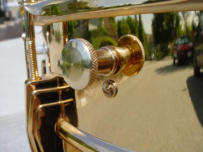
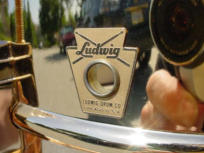
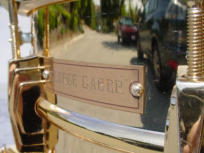
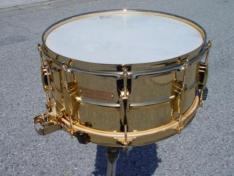
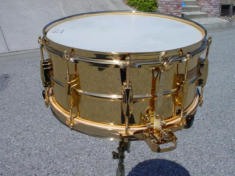
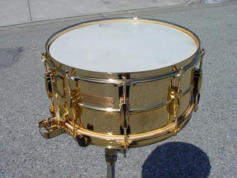
This is a rare 1926 (Indianapolis-era) 6x14 Leedy gold plated Marvel Model snare drum. In this case "Marvel" meant, as
per the Leedy catalog:
1. "Releases and applies the snares as a unit, thus when returned to the head they are at normal playing tension".
2. "Gives you the right results from gut snares immediately upon applying them to the drum.
Snares are never overstretched or bound".
3. "Assures you full vibration under PP or FF blows without readjustment of tension.
The snares lie level and do not bend over edge of shell".
4. "Permits the use of different types of snares with the same drum by merely changing bridge. Done in 30 seconds.
All the snares are free of the head when the lever is dropped. Very fast to operate". Another interesting note from Leedy:
"If your drum stand arms are set too low to allow the Strainer to work free of same, simply bend up one arm...".
The Marvel strainer works at both ends with a round steel rod that revovles on the inside of a square brass rod which acts
as the truss or "bridge". The snare lifts straight off the head at both ends as a unit.
Does this sound familiar to all the Rogers Dyna-Sonic collectors out there?
A special thanks has to go out to my good friend and fellow collector, Steve Maxwell (Steve Maxwell Vintage & Custom Drums)
for finding this drum for me.
1920s Leedy 6x14 8-lug Gold Plated Marvel Model

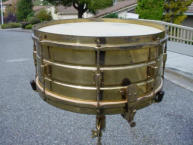
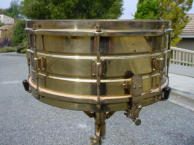
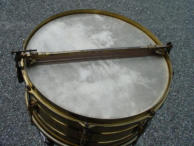
1932-34 Slingerland 8x14 (18 lug) Walnut DuAll Model

This one is at the top of the list in the WTF? files! Since this is a family show here we'll call WTF the "Where's That From?"
files, but you all know what I mean. It was late (2:00 am) and just before retiring to bed I decided to peruse my eBay bookmarks
one last time. I went through the Vintage, Leedy, Ludwig, WFL sections and there in the Slingerland section was this...
Where do we begin? Let's start with a little provenance. This drum came from eBay via a music store in Southern Ca. that was
selling this drum and other pieces for the son of the original owner who had long since passed away. His father was a
Vaudeville drummer in the 1920s and later on in the 1940s had a big band that played the ballroom circuit in the San
Bernardino (Ca) area.
The 8x14 shell is walnut and very clean so all that was needed was some lemon oil to clean and polish the walnut...but...I think
that this shell is a 3-ply shell which would be a first for me as far as DuAll shells go. Every DuAll that I own or have seen has a
solid shell. Was Slingerland not able to steam bend an 8" solid shell? Check out the photo and see what you think. The hardware,
ah...the hardware...18 lugs of pure weirdness. Our friend and fellow collector Harry Cangany saw this drum and emailed the
following: "Mike: I saw that 18 lug DuAll last night and laughed in astonishment--some formerly valuable 10 lugger got in the
hands of a mad man who drilled it for 8 more lugs.....let's look at the inside of the shell on that one!" So the questions are:
1. is this all original?...
2. is this an un-cataloged, one-off, special order? or...
3. "some formerly valuable 10 lugger got in the hands of a mad man who drilled it for8 more lugs"?
First off I looked inside the shell to see if there were any signs of a former "mad man" being there. I am happy to report (and
mildly relieved) that the drilling for the 18 lugs looks all original and uniform. To confirm this further I lined up a 10 lug Artist Model
and noticed that the 10 lugs on the Artist Model did not line up with any 10 of the lugs on this drum so more proof that this was an
original factory drilling. The cloud badge is perfectly centered between two of the 18 lugs so this could not have happened if this
drum had started out as a 10 lug drum. I took a look at the 10 lug Artist Model and imagined what another 8 lugs would look like
but in order to even things out the shell would have had to be drilled for 20 lugs. Further proof are the 18 brass wood screws that
are drilled into the top bearing edge that are perfectly aligned with every tube lug. Finally, you will notice that the snare gates on
the bottom rim of this drum have a smaller opening, 1 3/8" and a 2" center to center hole spacing as compared to a 2" opening
and 2 1/2" center to center on all of my 5x14 and 6.5x14 10 lug DuAlls. I see this as a factory modification in order to
accommodate 18 lugs evenly across the rims. In conclusion, my vote is that this is an original factory-drilled shell. The tube
lugs measure 5" end to end with a center to center hole spacing of 4.5". This is in comparison to a 6.5 x14 Slingerland shell that
has tube lugs that are 4" end to end and 3.5" center to center. This drum has all original nickel plated hardware that is in great
shape but really dirty and needed a thorough cleaning and polishing. Everything cleaned and polished up nicely. The DuAll
mechanism works fine and the snare wires are intact. An interesting modification that I noticed was that the extension lever had
to be bent/angled in order to clear the extra long tube lug. There was no batter head (tell me something that I already didn't know)
but I went to my stash and found a nice batter head that fit perfectly onto the Tone Flange. There was no bottom (slunk) head
either but that was an easy fix. There you have it, right out of the WTF? files. Now all that I need are 4x14, 5x14 and
6.5x14 18 lug DuAlls to make this a full set...(enter NSMD readers falling to the floor in hysterics).
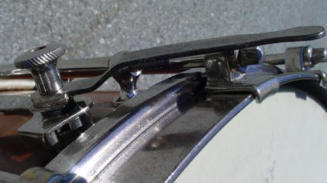
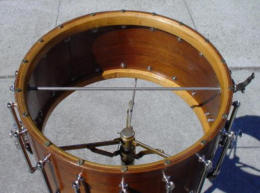
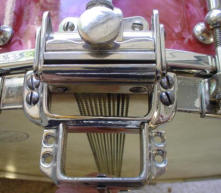
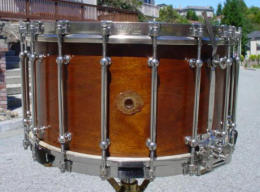
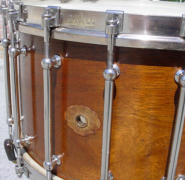
1939 WFL 7x14 WMP Twin Sensitive Hollywood Swing Model

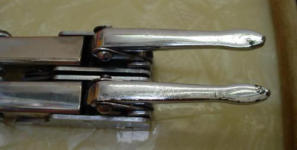
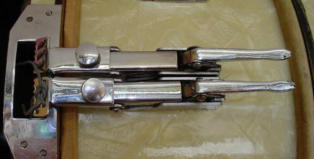
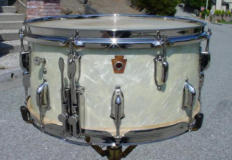
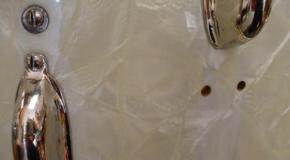
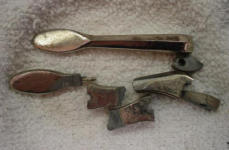
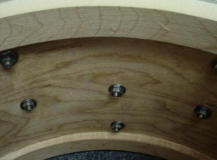
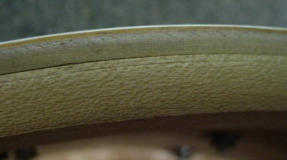
This model usually comes with 8 of the infamous "Zephyr" streamlined tension casings. This particular drum has a lug design
that I have never seen on any WFL drum from the 1930s-40s (or any era) and, the 16 lugs are staggered (8 top and 8 bottom)
on this shell. The lug design looks pretty basic i.e. a pressed metal shell casing, an insert and a spring. There is no real way to
keep the spring secure inside the rounded lug design so the first lug to come off of the shell allowed the loose spring to fly across
the room. Reassembling the lugs back onto the shell was also a drag but I succeeded after I got a little assembly groove going.
Notice how WFL had to modify the lug directly above the twin strainers as compared to the rest of the lugs. The twin strainer lever
design on this drum is also something that I have never seen. The two levers are very oversized as compared to the
smaller/thinner twin strainer levers on all of my other WFL drums and any others that I have seen. Both levers came to me broken
so I took them to my miracle worker machinist, Abe Abello so he could rebuild them for me. The photo tells the story; these levers
are made of crap pot metal and literally disintegrated when any pressure was applied to them. Any restorative welding or repair
was out of the question. I am astounded that this company would use a crappy metal like this on parts that would be in constant
use...the bean counters at WFL won that round. All that could be done was to fabricate a new pair of levers and reattach them to
the main twin strainer mechanisms. I commend Abe on his work, I think that he did a great job. All of the nickel plated hardware
was in very good shape so a basic cleaning and polishing was all that was needed.
The shell is not the standard WFL 3-ply mahogany shell with reinforcement rings as the catalog states. This shell is 3-ply but the
inside of the shell has a maple veneer, so we have, starting from the outside, the WMP wrap, a thin mahogany veneer, a thick
mahogany piece and the maple interior veneer with maple reinforcement rings. The WMP was a tad "ivoried" but my usual
regimen of plastic cleaner/polish knocked off a few layers of schmutz and brought back some life to the WMP finish.
Original WFL heads top and bottom and both sets of original wires rounded out this cleaning/restoration.

1911-12 4x14, 5x14, 6.5x14 nob Ludwig & Ludwig Standard Models
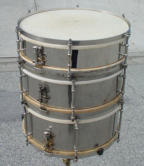
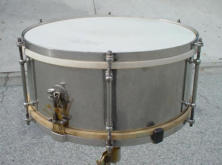
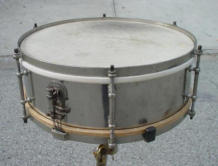
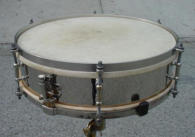
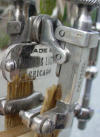
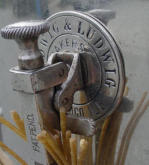
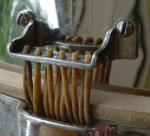
I decided to keep the restoration/preservation of these 3 drums to a minimum, a "soft" cleaning/restoration as we call it.
Shells/Hardware:
The drums were in very good shape given the fact that they are pushing 100, (we should all hope to look this good at 100 yrs.
old!). I used Simple Green to clean the years of schmutz that accumulated on the shells and hardware. All of you know that I
constantly preach: "rust does not sleep"...so any rust was handled by my trusty Dremel tool, soft steel brushes and 0000 steel
wool (note to the Purists: don't get your undies in a bunch, no damage was done to the hardware with the 0000 steel wool).
The 4x14 came to me missing the top rim so I had to have one fabricated. My machinist Abe Abello came through once again,
notice how he nailed the "ears". If I hadn't pointed this out to you the top rim would have passed easily, that's how good Abe is!
A thanks also goes to Les and Brian at Avenue Plating for the nickel plating.
Badges:
The 5x14 and 6.5x14 both have the round Ludwig & Ludwig badge that has the center hole to attach the flip down strainer.
The 4x14 has the "dog tag" badge that sits right below the hole to attach the flip down strainer. I'm thinking that the "dog tag"
badge came first followed by the round Ludwig & Ludwig badge. What do you think?
Calf heads and original gut/silk wound wires rounded out these restorations.


1936 (Anniversary) Ludwig & Ludwig 5x14 Abalone Pearl Standard Model
First of all many thanks to my (our) friend and fellow collector Bun E. Carlos for selling me this drum.
This drum is 75 yrs. old this month (0436) so it's kind of cool to be cleaning/restoring this drum at this time.
Abalone Pearl was a short-lived finish and was in the L&L catalog for only 2 years, 1936-1938.
The shell/finish was in great shape and only needed a basic cleaning/polishing. There are traces of colors
left but can you imagine what this finish looked like new? An interesting fact is that the badge is the
1920s-early 1930s oval brass badge. I've read where L&L was in the habit of using up all of their supply of
parts so it is logical to assume that this badge was probably at the bottom of the badge bin or at least mixed in
with the white oval badges that are normally seen on these drums (1950s WFL butt plates on 1960’s
Ludwig snare drums comes to mind). John Aldridge also confirmed this by informing me that he has seen
a few 1935- drums with brass oval badges. It was also comforting to see that the grommet was untouched.
The nickel hardware was in good shape with the usual rust areas on the tension rod threads, steel parts of
the Professional strainer and butt plate bridge. Everything cleaned up and polished up nicely.
Calf heads top and bottom and the original James Snappi wires rounded out this restoration.
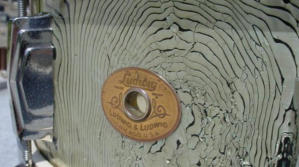

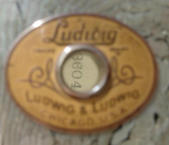
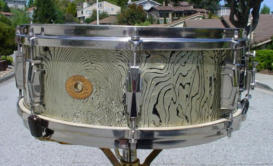

1926-27 Ludwig & Ludwig 5x14 Ludwigold/Brass Standard Model
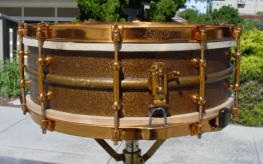
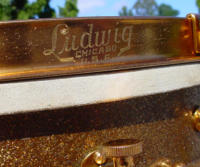
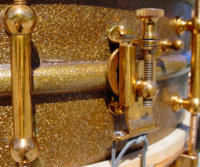
This one came to me from a collector that was moving out of state in order to be able to take care of a family member.
He was happy to see the drum go to a good home.
Standard Models in Ludwigold and Stipel Gold are a little harder to find, we see more Super-Ludwig Models than
Standard Models...at least I do.
The Ludwigold shell was in pretty good shape and needed just a basic cleaning. There was one good sized dent
that I contemplated taking care of myself but once I disabused myself of that silly concept (as you all do not know
what damage I am capable of with a hammer) I brought the shell to my guys at Avenue Plating where Les saved
the day with his special hammers. Les was able to "massage out" the dent like the pro that he is...and...with no
loss or damage to the Ludwigold finish. Crisis averted and the shell was complete.
The Artgold hardware was all there and in very good shape with at least 95% of the Artgold lacquer intact.
There were a few tarnished areas on the ends of the tube lugs/collar hooks and some rust on the threads
of the tension rods but all that was easy to clean up. I love that "Ludwig Chicago U.S.A." engraving on the top rim!
Calf heads top and bottom and some correct of-the-era James Snappi wires finished off this cleaning/restoration.
You all know me and my quest of obtaining "sets of"...I already have a 6.5x14 brass Ludwigold Standard so
I'm still looking for a 4x14 brass Ludwigold Standard.

1929 Slingerland 5x14 Lavender Pearl Tone Flange Artist Model
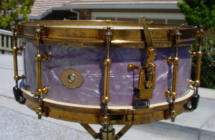
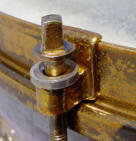
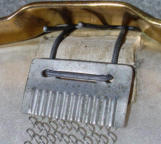
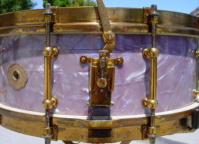
The existing literature shows that Lavender was a catalogued Slingerland finish for only one year,1929. This makes sense
as this finish does not stand the test of time well at all.
The Shell/interior:
There was a lot of Lavender left under the layers of dirt and grime that had accumulated on the exterior but I needed to
implement my full cleaning and polishing regime to bring this out. I am happy with the results as the photos show. The solid
mahogany (maple reinforcement rings) interior was in great shape and only needed a basic cleaning. The cloud badge and
grommet are both tight and in very good shape.
The hardware:
Ah, the hardware, the Slingerland Artgold hardware... The trick here is to try to salvage as much of the original Artgold finish
as possible because restoring Slingerland Artgold is a lot harder than L&L Artgold. The Slingerland Artgold finish (lacquer)
has a different shade of gold to deal with. The hardware on this drum was a little rough and I contemplated just leaving it
as it was but I couldn't do it, I had to give it the old "Curotto try" and you know my mantra: "rust does not sleep". I started
with some Simple Green degreaser to clean off the layer of schmutz and then I used my trusty Cape Cod Polishing Cloths
to clean/polish up the tarnished areas. This was followed up with a few coats of Nikolas #2105 Special Gold Colored Lacquer.
I concentrated on the affected areas (after cleaning up the rust/tarnish) and was pleasantly pleased (and surprised) with
the outcome.
There are some cool artifacts that came along with this drum and were added by a drummer of yesteryear. It was kind of fun
to see that some drummer way back when was tweaking with his drum. Admittedly minor stuff but still cool to see. All of the
tension rods, tube lugs and 3 point strainer had a copious amount of heavy grease that obviously kept things lubricated but
was a pain to clean. The slunk head has two pieces of tape at each end to protect the head from the Snappi wire end pieces.
Finally, there were 20 "after-market" oversize tension rod washers that our drummer of past used instead of the normal brass
tension rod washers. The heads of the tension rods fit perfectly and seat nicely into the "top" of the washers so I decided to
leave them as is and include them with the restoration. They look kind of cool. And lest we not forget...the ever present,
crooked, dipped to the right drilling for the 3 point strainer.
One can see why these Tone Flange Models were short-lived as we all know the frustration of trying to fit a head onto the
Tone Flange. Fortunately the original (or at least an of-the-era) batter head and a slunk (bottom) head came with this drum
so all that was needed was some James Snappi Wires to round out this restoration. This one took a while but it was worth it.

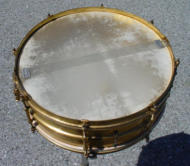
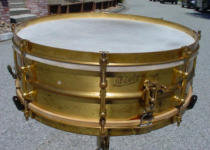
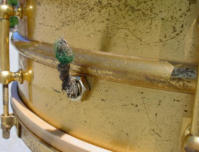
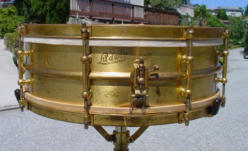
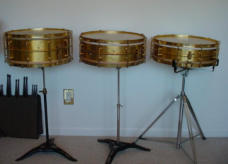
I pretty much left this 8 lug Standard Model as-is except for a little lemon oil on the shell and hardware.
There was a heater/light bulb hole in the shell but Iwas able to install an old light bulb fixture that I
got from another drum, notice the original wiring.
Of-the-era heads and original Snappi Wires rounded out this cleaning/light restoration.
1925 Ludwig & Ludwig 5x15 All Gold Standard Model

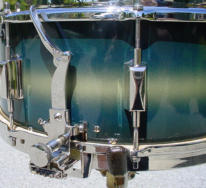
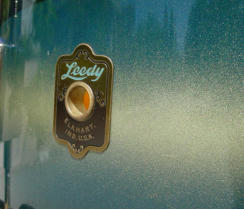
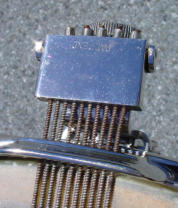
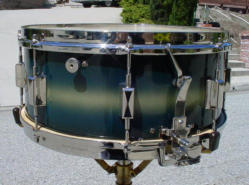
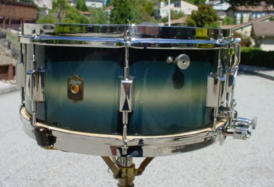
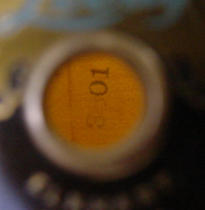
1938 Leedy 6x14 blue/silver/blue Duco Broadway Parallel
This is one of those rare finds that needs absolutely nothing done to it. The b/s/b Duco is in excellent-plus
condition with almost no dings, the nickel hardware is in near mint condition, the original Broadway Parallel
wires are intact, the bottom head is original and the top head is at least of-the-era.
That's all there is to report...enjoy!

1920s WILSON GOLD PLATED/WHITE LACQUER 4x14
SEPERATE TENSION THUMB-ROD SNARE DRUM
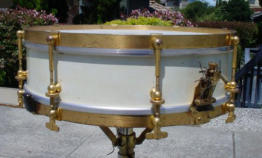
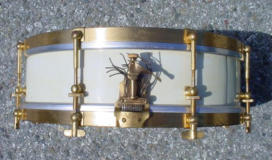
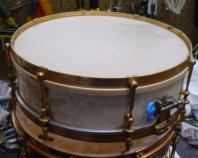
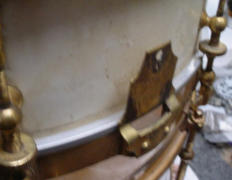
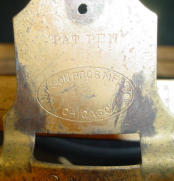
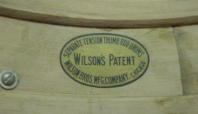
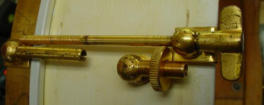
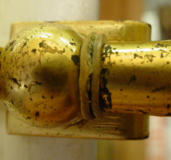
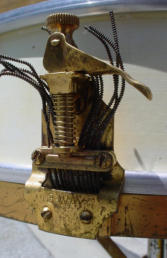

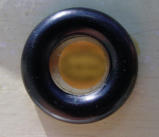
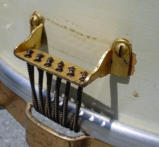
The Shell:
The 4x14 shell looks to be solid maple with maple reinforcement rings. There is no badge but there is a Leedy-esque black
grommet. There is avery nice and excellently preserved Wilson Bros. Mfg. Co., Chicago tag directly opposite the grommet.
The outside is white lacquer that had accumulated 85+ years of dirt, grime and assorted schmutzes of yesteryear. A light
cleaning and polishing compound brought some life back to the white lacquer.
The Hardware:
I'm always a sucker for gold plated hardware. The gold plated hardware also had a fair amount of dirt, grime and schmutz
but my trusty 3-in-1oil (thank you George Way) cleaned everything up nicely while still keeping the "age" of the hardware
intact. A special thanks goes out to my friend, fellow DFO Forumite and fellow collector Stephen Traversi for supplying me
with the parts I needed to complete the strainer, Stephen saved the day!
Another special thanks goes to Les Hadnagy of Avenue Plating for matching up the gold plating on the newly acquired strainer
parts. Les left all of the "age" on the parts that he gold plated and this blended nicely with the original gold plating. Unfortunately
calf heads didn't work on the drum. The calf heads went on fine but the thumb-rod tuning threads maxed out way before the
heads were sufficiently tightened so I had to use modern day heads that sat higher therefore allowing more thread room in the
top claw for the thumb-rod threads to catch. So much for authenticity.
Notice the thumb-screw washers, they are made out of calf, kind of cool, I never saw that before. The butt plate is the tray style
as we have seen on late-teens and early 1920s L&L snare drums. Silk-wound wires rounded out this restoration. This is by far,
not my favorite tensioning system.
Without getting into a graduate thesis on the workings of the Wilson separate tension thumb-rod mechanism, allow me to just
summarize. Wilson stresses theimportance of being able to individually adjust (tighten/loosen) the top and bottom heads and
points out that simultaneous tensioning will result in the bottom (snare) head tightening up quicker because of the thinness of
the slunk head as compared to the thicker batter ("beater" as Wilson says) head. Here is where that little "lock wheel" near the
bottom flesh hoop comes into play. The threaded thumb-rod slides through the bottom lug and screws into the top claw, so this
is where your simultaneous (top and bottom) tuning takes place. Turning the lock wheel downward and securing it to the top of
the bottom flesh hoop will cause the bottom tuning to be locked therefore allowing additional tightening of the top head. Release
the thumb wheel and you are back to the simultaneous tuning mode. There you have it, a bit crude, not anywhere near the
Gladstone tuning or traditional separate tensioning but still better than single tensioning, I guess.
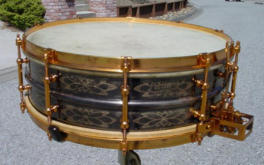
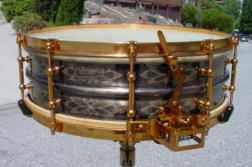
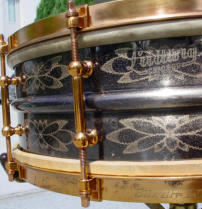
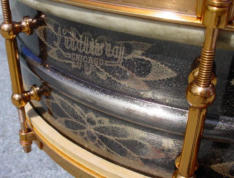
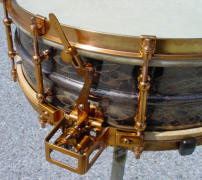
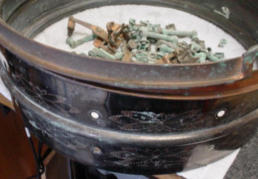
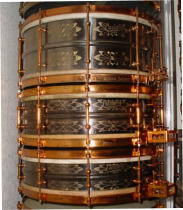
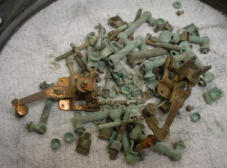

1925-26 5x15 LUDWIG & LUDWIG 12 pt. FLORAL DeLUXE SUPER-LUDWIG
The Shell:
There were a few dings and dents in the shell but nothing that would constitute being a deal killer. Minor dings and dents are
within my "ding and dent fixing expertise" so I was able to fix these myself. The original clear coat lacquer was beyond restoring
via my polishing methods so I stripped the old lacquer off down to the black nickel/engraving. Other than a bit of green tarnish
here and there that was relatively easy to clean, the black nickel and 12 pt. floral engraving were in pretty good shape. Thanks
goes to Brian Hadnagy of Avenue Plating for the expertly applied lacquer clear coat. The shell came out great.
So much for the easy part of this restoration...
The Hardware:
The hardware was a mess, 75% of it was green as the before photo shows...so another trip to Avenue Plating. Les Hadnagy
took the hardware and began to get the tarnish cleaned up via his cleaning tank. We were able to salvage the original copper
plating on the top and bottom rims, most of the Super mechanism, 8 collar hooks, both snare guards, 4 snare guard clips and all
of the attachment screws. So for those of you who are keeping score; the parts that needed to be copper plated were: the
thumb screw, extension lever, 12 collar hooks, 20 tension rods and 20 washers. Les knows, per my instructions,to keep all of
the "age" on these original parts, meaning that he doesn't buff out the imperfections/wear marks before he copper plates the
parts. This technique allows the parts to retain their age and look authentic. Once I got everything polished all that was left was
the application of the gold lacquer spray (Nikolas Special Gold Colored #2105 Lacquer). The lacquer went on well, the hardware
ended up looking clean and as I like to say: "classically-aged and era-correct".
Thanks also goes to Bill Wanser for rebuilding the Super wires. Top and bottom of-the-era calf heads rounded out this endeavor.
As I said earlier, another "set" is completed; this 5x15 DeLuxe 12 pt. floral Super-Ludwig fits right in middle of my 4x15 and
6.5x15 DeLuxe 12 pt. floral Super-Ludwigs.

The best way to communicate with Jim is via E-mail to: savoldi1@aol.com

Curotto Collection













